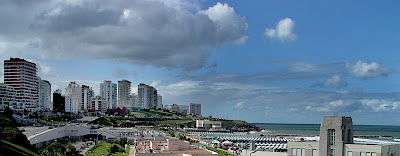 |
| From MarDelPlata_09 |
I recently returned from a 5.5 hour bus ride South of Buenos Aires to the city of Mar del Plata. It is a beautiful place situated on the edge of the Atlantic Ocean with a population of over a half million. Unlike Oregon, the water temperature, 3 to 4 months of every year, is perfect for swimming and body surfing without the need of wet suit.
During January and February the city is packed with sun worshippers enjoying the sand and sea, while two months on either side of summer offer respite for those who prefer more open space. In January you’ll find the lawyers, doctors, and their families. The Argentine legal system pretty well shuts down for the month. In February, you’ll find the teachers and union worker, while in March many retirees visit. The kids are back in school and prices have dropped considerably.
 |
| From MarDelPlata_09 |
The seashore is lined with many high rise apartments for rent, all with incredible views. And on the beaches you will find literally thousands of temporary cabanas. It’s really a sociological phenomenon. The tents look like apt building complexes turned on their side. They are beehives of activity, many equipped with table and chairs for card playing or smoozing.
Many Argentines seem to enjoy the density and crowded beaches, though I myself prefer the more isolated beaches a 20 minute bus ride away. There the beaches are cleaner and the water blue. Whatever one’s personal sentiment regarding the impact of development and cabana esthetic on Mar del Plata, all will enjoy the rich colors of tents and umbrellas.
 |
| From MarDelPlata_09 |
Mar del Plata has a wonderful Rambla or boardwalk that is around 10 kilometers long, In some places, the boardwalk is comprised of 2 levels, one at beach level, the other above the rocks and cliffs. It’s perfect for walking or jogging and many people do daily. And when you need to cool down, you can migrate to the ocean below. There are some 36 beaches, each delineated by an outcropping of rocks, like arms in a wide embrace, that calm the water for the kids at the edges of the beach and leave the midsection for the surfers.
The waves and wind at times travel unobstructed from Antarctica and on some blustery days, you would swear you were at the gateway to Patagonia. It makes walking a bit difficult but again reminds me of winter storms on the Oregon Coast without the biting cold.
 |
| From MarDelPlata_09 |
Mar del Plata is also an important fishing port. The boats can be seen leaving in the morning and returning in the evening. You can wander around the docks where there is a lazy colony of sea lions to entertain. The smell is atrocious, but I think it’s from the fish processing plants. Know of any animals that sleep in a fouled nest? From the docks, you can walk to the large figure of San Salvador, patron saint of fishermen, located on a rocky jetty that reaches 30 blocks into the sea. Along the way, on your 40-minute walk, you will pass the rusting hulls of boats abandoned by their owners.
Mar del Plata also has a diverse cultural offering. There are shows, theatre, dance venues, and monthly art exhibitions. For the tangueros there is at least one milonga every night. On a Sunday we went to one that was really enjoyable. The locals were very warm and friendly. The level of dancing was above average and all were respectful of the line of dance. Interestingly I saw at least 4 familiar faces from the milongas of Buenos Aires.
The ocean is the missing ingredient in Buenos Aires. Yes, there is the coffee-colored river, but its just not the same experience. In Mar del Plata the fresh ocean air is enlivening. And how could I not mention that I had the best medialunas this side of the Rio Plata. Apparently, there are a plethora of local cooking schools where creativity, palatability, and cultural authenticity thrive.
 |
| From MarDelPlata_09 |
